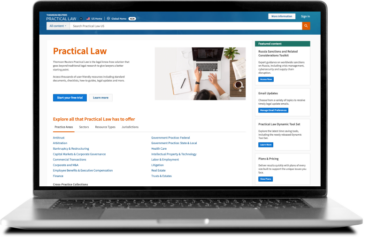Unfortunately, our economy continues to drift in an uncertain direction; if it does fall into recession one thing all in-house lawyers will see is an increase in the number of bankruptcy filings. While most will experience bankruptcy from the viewpoint of a creditor of the bankrupt company, some will have the unenviable task of seeing it up close and personal as counsel to the debtor filing for bankruptcy protection. Regardless, it is important for in-house lawyers to have a basic understanding of the bankruptcy process so that if such a filing becomes a realistic possibility, they can provide some initial advice to the business. This article will discuss the basics of what in-house lawyers need to know about the bankruptcy process from the viewpoint of a debtor:
Bankruptcy Law:
Bankruptcy law in the U.S. is part of a well-defined legal process set out in the US Bankruptcy Code (Title 11 of the U.S. Code) and special rules of bankruptcy procedure (and local rules), all of which both preempt and rely on state law. Bankruptcies are filed and decided in special federal bankruptcy courts before bankruptcy court judges. There are several different bankruptcy chapters each covering different types of debtors and situations, but the most common are Chapter 7, Chapter 11, and Chapter 13.
- Chapter 7: In this type of bankruptcy, also known as “liquidation” bankruptcy, the debtor’s non-exempt assets, if any, are sold by a trustee to repay creditors, and remaining eligible debts are discharged. It is typically suitable for companies with no viable prospects for reorganization.
- Chapter 11: Chapter 11 bankruptcy allows businesses to restructure their debts while continuing operations, known as debtors-in-possession (yes, the people who managed the company into bankruptcy are put back in charge). It involves creating a reorganization plan that outlines how the debtor will repay creditors over time.
- Chapter 13: This type of bankruptcy is primarily designed for individuals but may be used by sole proprietorship businesses. It involves the debtor creating a repayment plan to pay off their debts over a specified period.
For our purposes, we will focus on Chapter 7 and Chapter 11.
The Bankruptcy Process:
When a company’s debts are greater than its assets it becomes “insolvent” and can file for bankruptcy protection. In reality, many companies work hard to correct an imbalance between debts and assets and see bankruptcy as a last resort. If, however, bankruptcy is the only (or best) option for the company, then it will engage bankruptcy counsel to help guide the process (this is critical – bankruptcy is not a process for the uninitiated). One key thing to remember about bankruptcy is that it is designed to either get the bankrupt company back in business or ensure it is liquidated in an orderly manner. Regardless of which path is chosen, the process is also designed to ensure that similarly situated creditors are treated the same in terms of a share of the proceeds of sale or as to the plan for reorganization.
Once a petition for bankruptcy is filed, several things happen automatically:
- Automatic Stay: An automatic stay goes into effect with no further action needed on the part of the debtor. The stay halts virtually all collection activities by creditors, including lawsuits, foreclosure proceedings, and collection calls. There are steep penalties for creditors that violate the stay. The stay gives the debtor a chance to catch its breath and work to reorganize the business – without the hassle of creditor lawsuits or other actions – so that it can continue as a going concern, if under Chapter 11, or liquidate the assets if Chapter 7 is invoked.
- Priority of Debts: Bankruptcy law establishes a hierarchy for the payment of debts. Secured debts, for example, debts secured by an Article 9 UCC filing, are generally given priority, followed by certain priority debts, such as tax obligations and employee wages. Unsecured debts, such as those typically owed to company vendors, may be paid if there are sufficient assets or funds available prior to discharge or liquidation.
- Executory Contracts: In Chapter 11, the debtor has the option to assume or reject certain contracts. These are known as executory contracts (contracts where the parties still have duties to perform) or unexpired leases. Creditors must continue to perform under contracts regardless and until the debtor assumes or rejects. If the debtor rejects a contract, it is terminated and no further performance is due by either party. Payment for amounts owed to the creditor under the contract is determined by the priority of debts. If the debtor assumes the contract then it must cure any default (pre and post-filing for bankruptcy). If the debtor fails to do that, the creditor will have a claim in bankruptcy with a higher priority than unsecured claims.
- Preferences: To ensure that all creditors are treated as evenly and fairly as possible, bankruptcy law will prevent debtors from favoring certain creditors over others shortly before filing for bankruptcy. These are called “preferences.” To qualify as a preference there must (a) be a transfer of the debtor’s property, either money or assets; (b) for the benefit of a specific creditor; (c) on account of an existing debt; (d) made within a certain period before the bankruptcy filing, usually 90 days; that (e) allows the creditor to receive more than they would have received through the bankruptcy distribution process.
If a transfer meets these criteria and is determined to be a preference, it may be subject to avoidance or recovery by the debtor or bankruptcy trustee, who can undo the transfer and reclaim the assets for the bankruptcy estate to distribute them more equitably among all the creditors. But, note that creditors and the court will be equally vigilant to ensure that the debtor makes no fraudulent conveyances, i.e., trying to hide assets from creditors or the court.
In Chapter 11, the debtor in possession is responsible for managing day-to-day business operations, making business decisions, obtaining financing, and seeking opportunities to maximize value for the creditors. Major decisions, such as the sale of assets or entering into new contracts, may require court approval. The debtor must propose a reorganization plan outlining how they intend to repay creditors over time and restore the business’s financial stability. The plan must be approved by the bankruptcy court and accepted by the creditors. The debtor must provide regular financial reports to the bankruptcy court and the creditors.
The End Game:
The point of the bankruptcy process is for the debtor to reorganize or liquidate. If Chapter 7, then the trustee attempts to recover the largest amount of cash possible through preference claims or the sale of debtor assets and distributes the proceeds to the creditors. In Chapter 11, the debtor must propose a reorganization plan. The plan typically includes provisions for renegotiating contracts, reducing debts, and modifying payment terms. The plan must be approved by the bankruptcy court and the affected creditors – who, among the unsecured creditors, have typically formed a creditors’ committee to help ensure the highest distribution possible to its members.
Ultimately, bankruptcy will result in the discharge of eligible debts, relieving the debtor from the legal obligation to repay them. However, not all business debts are dischargeable, such as certain tax obligations and debts arising from fraud or illegal activities. Lastly, when emerging from bankruptcy, the debtor will take steps to rebuild its credit and implement sound financial practices to reduce the stigma of filing and to encourage creditors and vendors to resume doing business the with “new” company. The legal department will likely have a role in all of this.
***
Of course, there is much more to the bankruptcy process than outlined above, but this is a good start to understanding a number of core issues. If you are an in-house lawyer with Practical Law you have access to an incredible amount of content that will help you navigate the bankruptcy process, from tool kits to templates to checklists. It’s all just a click away.











